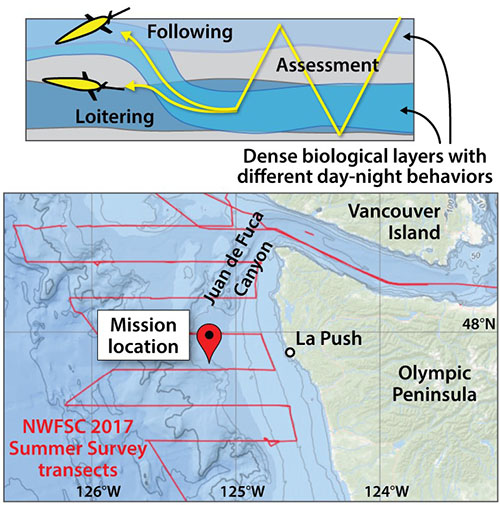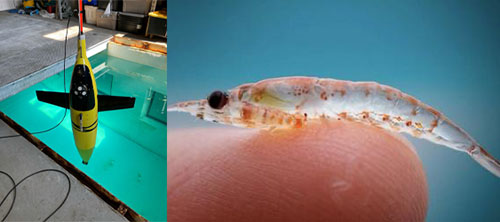
Wu-Jung Lee, Principal Investigator/Senior Oceanographer at University of Washington Applied Physics Lab
From August 27 to September 15, 2021, a team from the University of Washington Applied Physics Lab (UW-APL) will carry out an expedition at the shelf break off the coast of Washington. The main goal of this expedition, funded by NOAA Ocean Exploration via the Fiscal Year 2020 Federal Funding Opportunity for Ocean Exploration, is to collect data for developing new acoustics-based methodologies that will pave the way for persistent, distributed observation of organisms that occupy the middle levels of the ocean food web (mid-trophic organisms), such as zooplankton and small fish, using gliders. Operating aboard Research Vessel (R/V) Jack Roberston in the Juan de Fuca Canyon offshore of La Push, Washington, the team will deploy an autonomous underwater glider (Seaglider ) equipped with an acoustic Doppler current profiler (ADCP) and collect accompanying data sets using a moored and a ship-based echosounder (Figure 1).

Figure 1: Overview of the field testing plan. (A) A Seaglider will sample dense biological layers first in typical down-up dives and then be commanded to follow the layers for targeted data collection in loitering dives. (B) The field work region right off the shelf break offshore the Washington coast. Image courtesy of Wu-Jung Lee, University of Washington Applied Physics Lab. Download largest version (jpg, 412 KB).
Despite their vital role in marine ecosystems, the economy, and our food supply chain, mid-trophic level animals are among the least understood animals in the ocean. Currently, researchers lack the tools to adequately study these animals, producing a gap in knowledge that disrupts informed policymaking for sustainable resource management. To bridge this gap, the team is developing methodologies to enable more efficient observation of mid-trophic organisms. Traditionally, this type of coupled physical and biological data collection relies on ship-based equipment, which presents logistical and financial constraints. Gliders, with their unparalleled endurance and access to deep, remote ocean environments, provide an efficient and cost-effective solution to these challenges. With the recent advent of a glider-specific ADCPs, researchers can simultaneously collect biological and physical data (e.g., ocean currents) at fine scales throughout the course of the glider’s dive (Figure 2).
The team will deploy the Seaglider right off the shelf break offshore La Push, Washington. The initial phase of Seaglider operations will involve coordination with R/V Robertson so that the acoustic backscatter data collected from both platforms can be compared and analyzed jointly. The team will also deploy an echosounder mooring anchored at 250-350 meters (820-1,150 feet) below the surface, with a goal to observe aggregations of Pacific hake (Merluccius productus) and Pacific krill (Euphausia pacifica). This mooring will serve as a waypoint for Seaglider navigation and provide another data set for joint analysis. During the expedition, the team will command the glider to perform the regular down-up dives through the water column and the loitering maneuver at specific depth ranges to collect data with different spatial characteristics that will be later explored in algorithm development.

Figure 2: (Left) An ADCP-equipped Seaglider is tested on-shore before the expedition. (Right) An example of a zooplankton that this expedition will study. Krill are large zooplankton that are an important food item for many fish, seabirds, and marine mammals. Image courtesy of Wu-Jung Lee, University of Washington Applied Physics Lab (left) and NOAA Northwest Fisheries Science Center (right). Download largest version (jpg, 116 KB).
The expedition target location is in close proximity to one of the transects of the NOAA Fisheries Northwest Fisheries Science Center (NWFSC) Pacific Hake Survey. The team will coordinate with NOAA Ship Bell M. Shimada and command the Seaglider to sample near trawled hake aggregations. The trawl samples provide biological ground truth, such as length distribution, that is conducive to interpreting acoustic data for useful biological information, such as abundance.
This project will deliver new analysis techniques and practical recommendations for building a coordinated network of ADCP-equipped gliders for biophysical data collection. The interdisciplinary combination of acoustic and autonomous technologies will provide data that are otherwise unattainable at large scales. Such data will inform ecosystem-based management approaches and drive science-based decision-making in support of the blue economy. This project directly supports NOAA Ocean Exploration’s mission to explore the ocean for national benefit and has the potential to revolutionize strategies for exploring living marine resources in the global ocean.
Published August 27, 2021